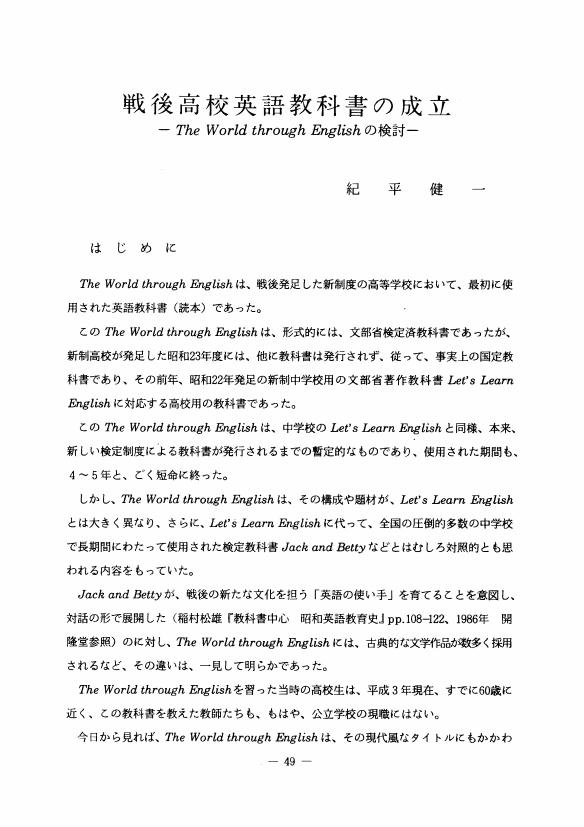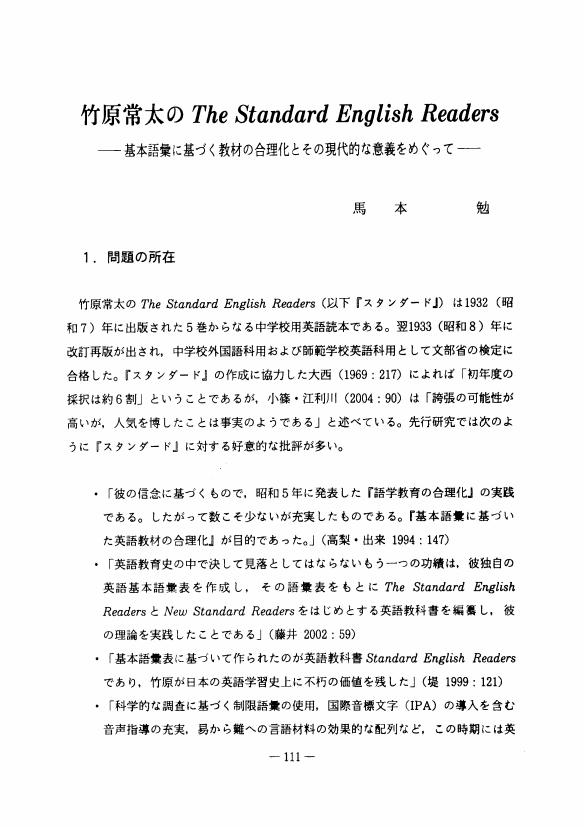1 0 0 0 OA 日本英語教授法史におけるOllendorffの教授法の位置づけ
- 著者
- 平賀 優子
- 出版者
- 日本英語教育史学会
- 雑誌
- 日本英語教育史研究 (ISSN:0916006X)
- 巻号頁・発行日
- vol.23, pp.75-100, 2008-05-10 (Released:2012-10-29)
- 参考文献数
- 59
1 0 0 0 OA 文部省著作Let's Learn English の編集とその周辺
1 0 0 0 OA 英語教育縮廃論とは何か
- 著者
- 山田 豪
- 出版者
- 日本英語教育史学会
- 雑誌
- 日本英語教育史研究 (ISSN:0916006X)
- 巻号頁・発行日
- vol.11, pp.111-129, 1996-05-10 (Released:2012-10-29)
- 参考文献数
- 12
1 0 0 0 OA 東京文理大英文科の閉学-福原麟太郎を中心に-
- 著者
- 祐本 寿男
- 出版者
- 日本英語教育史学会
- 雑誌
- 日本英語教育史研究 (ISSN:0916006X)
- 巻号頁・発行日
- vol.16, pp.45-63_1, 2001-05-10 (Released:2012-10-29)
1 0 0 0 IR 伊藤和夫の「受験英語」教育における「教養主義」 : 「構文主義」との関係から
- 著者
- 藤村 達也
- 出版者
- 日本英語教育史学会
- 雑誌
- 日本英語教育史研究 (ISSN:0916006X)
- 巻号頁・発行日
- no.34, pp.131-148, 2019
This study attempts to identify the nature of Kyoyo-shugi (self-cultivationism) m the English teaching for university entrance examinations by Kazuo Ito, an English teacher at Sundai Preparatory School. This paper fi江 stdescribes his methodology for reading English, so-called Kobun-shugi. It emphasized the distinction between reading English and translating it into Japanese. Then, the characteristics of his Kyoyo-shugi are discussed in relation to Kobun-shugi. He attached great importance to Kyoyo-shugi, but didn't express it in teaching English for entrance examinations. This paper concludes that Ito utilized Kobun-shugi to enable students to read English so as to pass university entrance examinations, and that at the same time he aimed to embody cultural values of Kyoyo-shugz through Kobun-shugi. Thus, his Kyoyo-shugi was based on Kobun-shugi.
- 著者
- 平本 哲嗣
- 出版者
- 日本英語教育史学会事務局
- 雑誌
- 日本英語教育史研究 (ISSN:0916006X)
- 巻号頁・発行日
- no.35, pp.1-22, 2020
1 0 0 0 鳥取県が生んだ英語
- 著者
- 速川 和男
- 出版者
- 日本英語教育史学会
- 雑誌
- 日本英語教育史研究 (ISSN:0916006X)
- 巻号頁・発行日
- vol.10, pp.49-57, 1995
1 0 0 0 幻の三省堂和英大辞典-神田から竹原へのある書簡をめぐって-
- 著者
- 堤 美佐子
- 出版者
- 日本英語教育史学会
- 雑誌
- 日本英語教育史研究 (ISSN:0916006X)
- 巻号頁・発行日
- vol.16, pp.69-84, 2001
- 著者
- 馬本 勉
- 出版者
- 日本英語教育史学会
- 雑誌
- 日本英語教育史研究 (ISSN:0916006X)
- 巻号頁・発行日
- vol.20, pp.111-130, 2005
1 0 0 0 『スタンダード和英大辞典』編者竹原常太
- 著者
- 堤 美佐子
- 出版者
- 日本英語教育史学会
- 雑誌
- 日本英語教育史研究 (ISSN:0916006X)
- 巻号頁・発行日
- vol.14, pp.121-139, 1999
- 著者
- 石井 俊彦
- 出版者
- 日本英語教育史学会
- 雑誌
- 日本英語教育史研究 (ISSN:0916006X)
- 巻号頁・発行日
- vol.13, pp.97-108, 1998
1 0 0 0 第33回大会講演 英語教育論争から考える
- 著者
- 鳥飼 玖美子
- 出版者
- 日本英語教育史学会事務局
- 雑誌
- 日本英語教育史研究 (ISSN:0916006X)
- 巻号頁・発行日
- no.33, pp.99-122, 2018
1 0 0 0 OA 「湘南プラン」について-その教授法と英語教育史における位置づけ-
- 著者
- 庭野 吉弘
- 出版者
- 日本英語教育史学会
- 雑誌
- 日本英語教育史研究 (ISSN:0916006X)
- 巻号頁・発行日
- vol.1, pp.1-15, 1986-05-15 (Released:2012-10-29)
- 参考文献数
- 29
1 0 0 0 文法=訳読法の成立過程
- 著者
- 茂住 實男
- 出版者
- 日本英語教育史学会
- 雑誌
- 日本英語教育史研究 (ISSN:0916006X)
- 巻号頁・発行日
- vol.2, pp.133-149, 1987
1 0 0 0 OA 英語学習参考書の研究-英単語参考書の系譜-
- 著者
- 速川 和男
- 出版者
- 日本英語教育史学会
- 雑誌
- 日本英語教育史研究 (ISSN:0916006X)
- 巻号頁・発行日
- vol.4, pp.181-206, 1989-05-01 (Released:2012-10-29)
1 0 0 0 OA 戦後高校英語教科書の成立-The World through English の検討-
- 著者
- 紀平 健一
- 出版者
- 日本英語教育史学会
- 雑誌
- 日本英語教育史研究 (ISSN:0916006X)
- 巻号頁・発行日
- vol.7, pp.49-86, 1992-05-10 (Released:2012-10-29)
- 参考文献数
- 9
1 0 0 0 OA 伊藤健三の生涯と業績
- 著者
- 伊村 元道
- 出版者
- 日本英語教育史学会
- 雑誌
- 日本英語教育史研究 (ISSN:0916006X)
- 巻号頁・発行日
- vol.13, pp.29-62, 1998-05-10 (Released:2012-10-29)
- 参考文献数
- 3
This is a biographical study of Ito Kenzo (1917-1995), an English teacher, textbook writer and applied linguist. Before World War II he was educated at Tokyo Higher Normal School under the influence of Harold E. Palmer's Oral Method. During and after the war he taught at three high, schools. He worked for ELEC, the English Language Exploratory Committee, studied the Oral Approach and participated in the compilation of textbooks. Later he was one of the chief editors of New Horizon English Course, a best-selling junior high school textbook for twenty-five years. He also lectured English Teaching Methodology for teacher-training courses at several universities for thirty-five years in all. His major works are English Linguistics and English Language Teaching (1982) and the Expression of Modality (1968). He also translated W. F. Mackay's Language Teaching Analysis and A. S. Horn's Guide to the Patterns and Usage in English,2nd edition. He is remembered as a wellbalanced applied linguist between theory and practice.
1 0 0 0 OA 外国人教師ロイ・スミス
- 著者
- 青木 庸敷
- 出版者
- 日本英語教育史学会
- 雑誌
- 日本英語教育史研究 (ISSN:0916006X)
- 巻号頁・発行日
- vol.12, pp.201-207, 1997-05-10 (Released:2012-10-29)
1 0 0 0 OA 鳥取県が生んだ英語
- 著者
- 速川 和男
- 出版者
- 日本英語教育史学会
- 雑誌
- 日本英語教育史研究 (ISSN:0916006X)
- 巻号頁・発行日
- vol.10, pp.49-57, 1995-05-10 (Released:2012-10-29)
- 著者
- 馬本 勉
- 出版者
- 日本英語教育史学会
- 雑誌
- 日本英語教育史研究 (ISSN:0916006X)
- 巻号頁・発行日
- vol.20, pp.111-130, 2005-05-10 (Released:2012-10-29)
- 参考文献数
- 32









